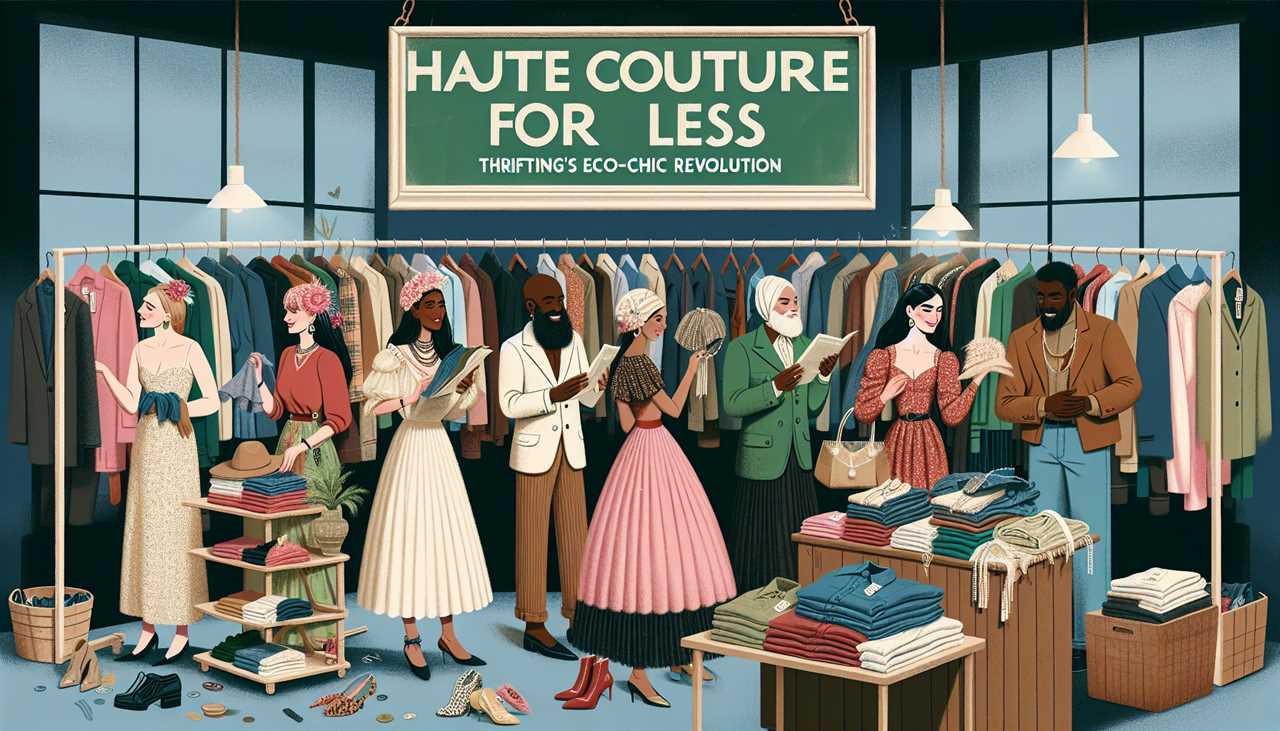Fashion
Haute Couture for Less: Thrifting’s Eco-Chic Revolution in Fashion Resale
The fashion industry is undergoing a transformation with the rise of secondhand designer resale, emphasizing eco-chic and sustainability. High-end fashion is

Listen to this Article
The Rise of Secondhand Designer Resale
We are witnessing a remarkable transformation in the fashion industry as secondhand designer resale takes center stage. This eco-chic revolution is reshaping how we approach style, sustainability, and consumption. The allure of high-end fashion combined with the principles of ethical consumerism has created a perfect storm, propelling the secondhand designer market to new heights.
Secondhand designer resale has become more than just a trend; it’s a movement that’s redefining luxury fashion. We’re seeing a surge in consumers who are not only fashion-conscious but also environmentally aware. These savvy shoppers are turning to pre-loved designer pieces as a way to indulge in high-quality fashion without the hefty price tag or environmental guilt.
Eco-Friendly Fashion: A New Era of Conscious Consumption
The eco-friendly aspect of secondhand shopping cannot be overstated. We’re observing a significant shift in consumer behavior as more people recognize the environmental impact of fast fashion. By choosing pre-owned designer items, we’re effectively extending the lifecycle of clothing and accessories, reducing waste, and minimizing our carbon footprint.
This eco-conscious approach to fashion aligns perfectly with the principles of the circular economy. We’re moving away from the traditional linear model of “take-make-dispose” and embracing a system where resources are used, reused, and recycled for as long as possible. Secondhand designer resale plays a crucial role in this circular model, keeping high-quality items in circulation and out of landfills.
Upcycling: Breathing New Life into Vintage Treasures
Upcycling has emerged as a creative force within the secondhand designer resale market. We’re seeing talented designers and artisans transform vintage pieces into unique, contemporary creations. This innovative approach not only preserves the essence of iconic designs but also adds a modern twist, appealing to a new generation of fashion enthusiasts.
The art of upcycling extends beyond clothing to accessories as well. Vintage designer bags are being reimagined with new hardware, embellishments, or even repurposed into entirely new items. This creative process not only adds value to pre-loved pieces but also celebrates the craftsmanship and quality of luxury fashion.
Ethical Consumerism: Making a Statement with Our Wardrobes
Ethical consumerism is at the heart of the secondhand designer resale movement. We’re becoming increasingly aware of the social and environmental implications of our purchasing decisions. By choosing pre-owned luxury items, we’re supporting a more sustainable fashion ecosystem and making a statement against the exploitative practices often associated with fast fashion.
This shift towards ethical consumption is not just about avoiding harmful practices; it’s about actively supporting positive change. Many secondhand designer resale platforms are partnering with charitable organizations, ensuring that a portion of their profits goes towards meaningful causes. This allows us to align our fashion choices with our values, creating a positive impact with every purchase.
Slow Fashion: Embracing Quality Over Quantity
The concept of slow fashion is gaining traction, and secondhand designer resale fits perfectly into this philosophy. We’re moving away from the frenetic pace of seasonal trends and disposable clothing, instead opting for timeless pieces that stand the test of time. Designer items, with their superior quality and craftsmanship, are ideally suited to this approach.
By investing in pre-owned luxury pieces, we’re not just acquiring clothing or accessories; we’re collecting wearable art. These items often appreciate in value over time, making them not just fashion statements but also smart investments. This shift towards quality over quantity is reshaping our relationship with fashion, encouraging us to build curated wardrobes that reflect our personal style and values.
Thrifting: The Thrill of the Hunt
Thrifting for designer pieces has become an exhilarating experience for fashion enthusiasts. We’re rediscovering the joy of stumbling upon a hidden gem, whether it’s a vintage Chanel suit or a pair of barely-worn Louboutins. This treasure hunt aspect of secondhand shopping adds an element of excitement and personal achievement to our fashion acquisitions.
The thrill of thrifting extends beyond personal satisfaction; it’s also about the stories behind each piece. Every pre-loved item carries with it a history, a tale of previous adventures and occasions. This narrative aspect adds depth and character to our wardrobes, creating a richer, more meaningful relationship with our clothing.
The Future of Fashion: Sustainable, Stylish, and Second-Hand
As we look to the future of fashion, it’s clear that secondhand designer resale will play an increasingly important role. We’re seeing major luxury brands embrace this shift, with some even launching their own resale platforms. This endorsement from the fashion industry itself further legitimizes and elevates the status of pre-owned designer items.
The technology driving secondhand designer resale is also evolving rapidly. Advanced authentication processes are ensuring the genuineness of luxury items, while virtual try-on features are making online shopping for pre-owned pieces more accessible and convenient than ever before.
In conclusion, the eco-chic revolution in fashion resale is more than just a passing trend; it’s a fundamental shift in how we approach style, sustainability, and consumption. By embracing secondhand designer resale, we’re not just saving money or making eco-friendly choices; we’re participating in a movement that’s reshaping the fashion industry for the better. As we continue to prioritize quality, sustainability, and ethical consumption, the future of fashion looks brighter, more diverse, and infinitely more exciting.

Hey there! I’m William Cooper, your go-to guy for all things travel at iMagazineDaily. I’m 39, living the dream in Oshkosh, WI, and I can’t get enough of exploring every corner of this amazing world. I’ve got this awesome gig where I blog about my travel escapades, and let me tell you, it’s never a dull moment! When I’m not busy typing away or editing some cool content, I’m out there in the city, living it up and tasting every crazy delicious thing I can find. Join me on this wild ride of adventures and stories, right here at iMagazineDaily. Trust me, it’s going to be a blast! 🌍✈️🍴







